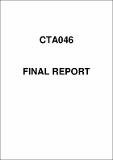| Abstract | Sugarcane is a complex aneuploid, polyploid, interspecific hybrid. Most breeding traits are complex and molecular markers associated with these traits are a tool that may assist breeders to more efficiently identify sugarcane clones containing these desirable traits. At the start of this project, molecular mapping in sugarcane was relatively new with maps being developed in interspecific crosses or within the selfed progeny of a variety. These maps relied heavily on the use of two major marker types, namely restriction fragment length polymorphisms (RFLPs) and randomly amplified polymorphic DNA (RAPDs), both of which had major disadvantages in their ease and reliability of use. The area of genomics was also very new, and genomics studies of sugarcane were being initiated in Australia, the USA, Brazil and South Africa, generating large amounts of gene information and potential markers for mapping in many traits of interest. The major objectives of this project were, therefore, to compare genomic regions associated with traits in Australian and French sugarcane populations, to demonstrate whether “candidate genes”, derived from partial gene sequences (termed expressed sequence tags, ESTs), were a useful strategy for the identification of closely linked markers for traits of interest, and to develop methods other than the RFLP approach to enable more rapid screening of ESTs in mapping populations. Using a variety of approaches, these objectives have been met as described below. Australian sugarcane maps have now been generated from two crosses involving Australian sugarcane varieties or elite material. Each cross has been used to generate two maps, one for the male and female parent of the cross. The Q1 population is derived from a cross between Q117 and 74C42, while the Q3 population is derived from a cross between Q117 and MQ77-340. The four maps now have approximately 300-450 markers each, using mainly PCRbased markers, namely simple sequence repeat (SSRs) and amplified fragment length polymorphisms (AFLPs). Our policy of using SSRs that have been mapped in the French variety R570, currently the largest published map with approximately 1000 markers, has assisted our comparative mapping attempts between the Australian and French maps. Many of the cosegregation groups identified in the Q1 and Q3 population maps have been tentatively aligned with Linkage Groups in R570 on the basis of shared SSRs. Using this approach, we have shown that the same SSRs are linked to sugar and fibre-related traits in both R570 and Q3 populations. This observation provides additional support to the usefulness of these SSRs in markerassisted selection. In addition, novel associations were also identified for both Q3 and R570 populations. These marker-trait associations could be due to different parts of the genome being mapped in the two populations, to novel alleles in the two populations, or to fixation of this region in one of the populations. The alignment between the R570 and Q3 population maps was more difficult than anticipated because most markers on the R570 map were AFLPs and because marker sizes had not been recorded for either map. AFLPs are plentiful but are more difficult to score accurately and comparatively. In addition, the low level of genome coverage in both maps (~33% for R570 and <20% for Q3) meant that genome comparisons could 3 only be made at the homology group level as it was likely that different linkage groups within a homology group had been mapped in the two populations. |

